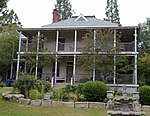Bret Harte Union High School
1905 establishments in CaliforniaEducational institutions established in 1905Public high schools in CaliforniaSchools in Calaveras County, California
Bret Harte Union High School is a public high school serving Angels Camp, California, the only incorporated city in Calaveras County, California. The school was established in 1905 and is named after American poet Bret Harte. The school's official address is 321 South Main, P.O. Box 7000, Angels Camp, CA, 95221. Some directories indicate that the school is located in the unincorporated community of Altaville, California, at 364 Murphys Grade Road, Altaville, CA, 95221,
Excerpt from the Wikipedia article Bret Harte Union High School (License: CC BY-SA 3.0, Authors).Bret Harte Union High School
South Main Street,
Geographical coordinates (GPS) Address Nearby Places Show on map
Geographical coordinates (GPS)
| Latitude | Longitude |
|---|---|
| N 38.07925 ° | E -120.55353 ° |
Address
Bret Harte Union High School
South Main Street
95221
California, United States
Open on Google Maps






